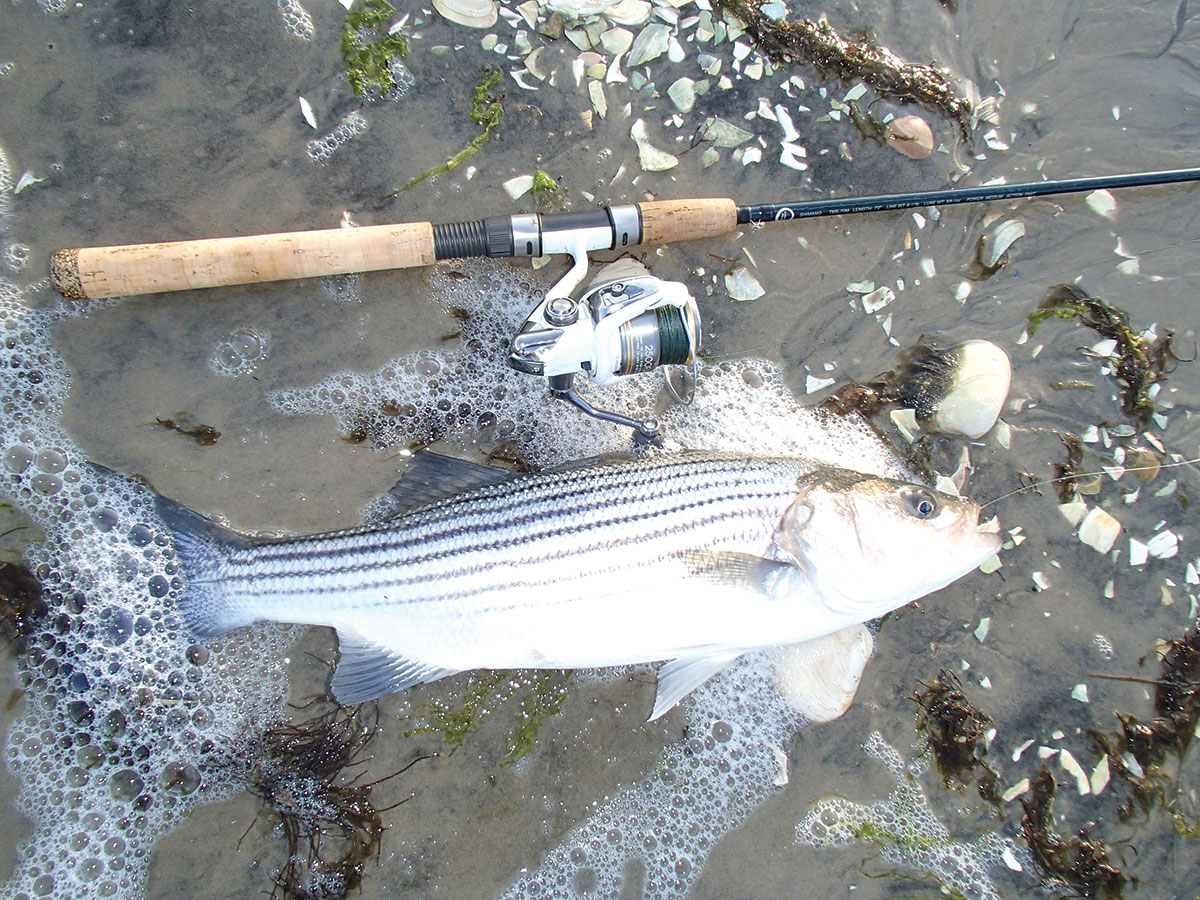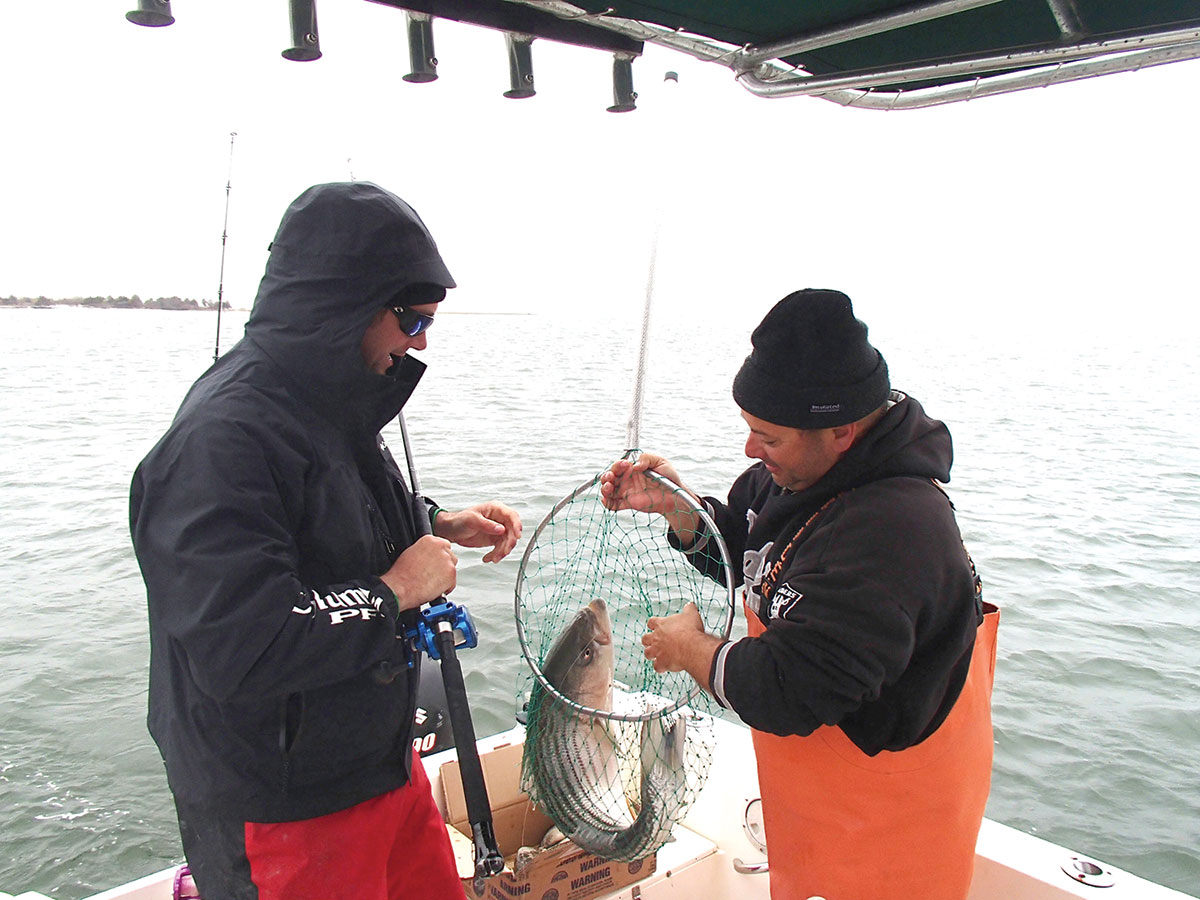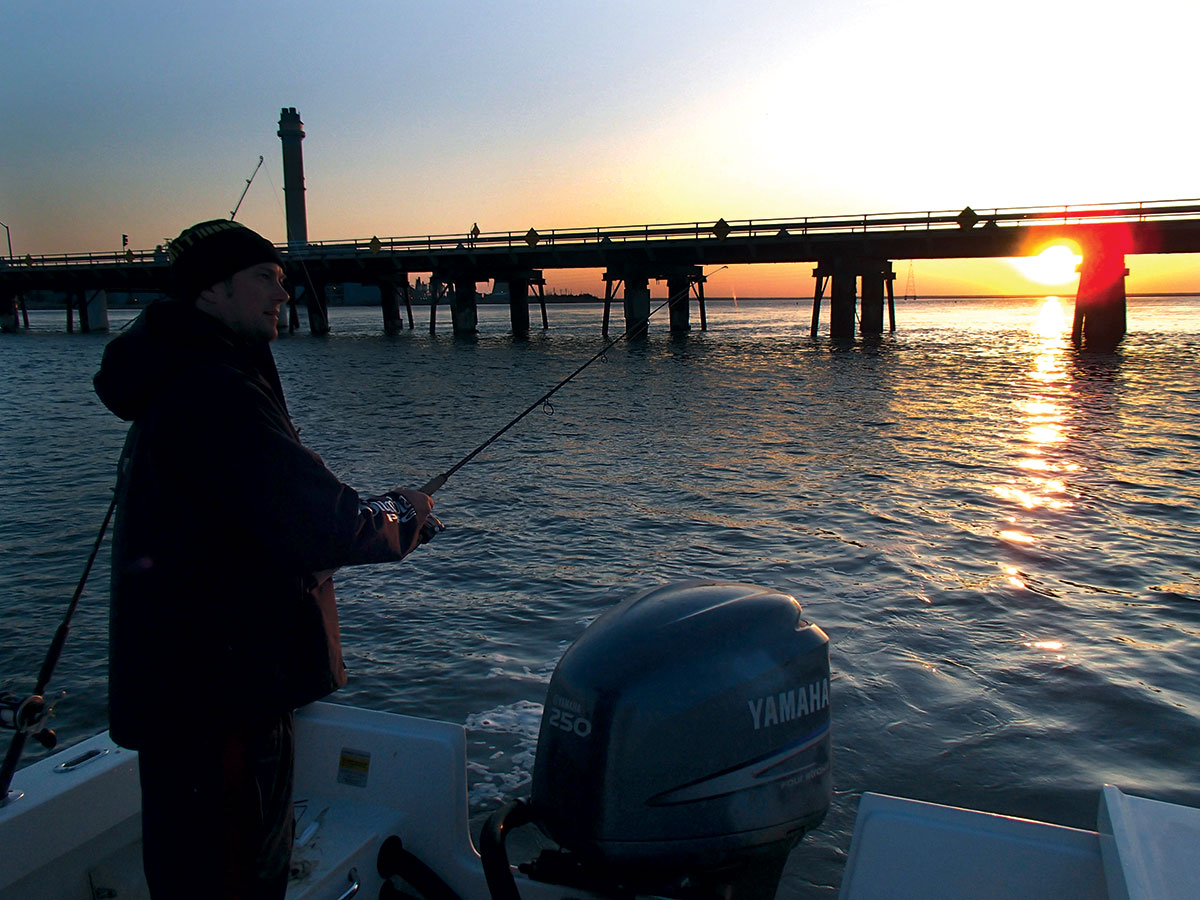
Celebrating the official opening of the striped bass fishery in New Jersey!
March 1 kicks off the backwater bass bonanza in the Garden State, with myriad opportunity to score the first striped bass of the year in rivers, bays and the surf. Mainly, backwater bass range from 18 to 28 inches and hang in waters that span between 45 and 54 degrees through the month, though the 48-degree benchmark seems to spark stripers to bite.
All along the Jersey Coast – from front to back – there are plenty of early spring hot spots to land your first linesider of 2017. Here’s a solid gameplan of tips, tactics and spots to point you in the right direction.
Clam Slick
Bait fishing really takes the cake for scoring March bass as early season stripers look to warm up and expend as little energy as possible to feed. The key to bringing them in for a bay bite – up north in Raritan Bay as well as in Barnegat Bay and south, is a clam chum slick. Start by anchoring on a ledge, draping chum pots laden with clam chum off each side of the bow. Bring a half bushel of fresh clams to break and crack off the stern every minute or two to send fresh scent in the water to get the shorty bass snappin’.
Rigs are fairly simple, drop down a fishfinder slide rig as it works best in the early season when stripers are still running cold and tend to take a little convincing to commit to a serious strike. The rig is constructed with a fishfinder slide with 2-ounce bank sinker, 75-pound barrel swivel, a 24-inch piece of 30-pound fluorocarbon leader and a downsized 3/0 baitholder hook on the end as the fish are generally of 18 to 26 inches long.
First shot stripers hang tight to the Morgan Creek spillout and the Keyport Flats in the Raritan Bay when they make their first push into the area as well as right inside Barnegat Inlet in Oyster Creek Channel; really, look for warmer waters along sandy flats and sedges behind most any of our local inlets from Indian River, DE to Little Egg, NJ to apply these tactics. A key benefit to this method the farther south you go this spring is the occurrence of early arriving black drum, particularly around mussel beds.
Surf Stick
Deadsticking fresh or salted clam baits is a premier way to score shorty bass from the surf in March. Along Raritan Bay, bayshore beaches lined with sod banks like Cliffwood, Union and Pebble Beach hold early season stripers as they hug the banks and warm up in the shallower depths alongshore. Bayshore clammers usually employ a three-way swivel and sinker clip with 3-ounce bank sinker, 28-inch shot of 40-pound fluorocarbon leader, and a size 4/0 baitholder hook on the end.
Bait the hooks with small cut clam tongues, not gobs of clam, so that the schoolies can effectively feel the barb of the hook on their fickle tap-tap-tap bites. Along the sandy coastline of the Atlantic, the corridor between Manasquan and Barnegat Light attracts spring stripers in the surf. Brick Beaches 1, 2 and 3, Seaside Park and Island Beach State Park put up decent numbers of March stripers, especially during the end of the outgoing tide and beginning of incoming.
In South Jersey, the Cape May Jetties off the Point are solid spots to sling clams. Find cuts and sloughs and launch clam baits out into the deepwater cuts during the low tide hours. Hi-lo rigs set with 3/0 to 4/0 baitholder hooks and a 3- to 5-ounce pyramid sinker work best surfside. When fishing, don’t set the rod in a sand spike; hold the rod in your hand to set the hook immediately on the quick-biting bass, as many times you have one shot to plant the hook on a drive-by hit before they move on.

Worm Slinging
Anywhere you find hard packed sod and sedge, you’ll find bloodworms, sandworms and tapeworms, and wherever you find worms, bass won’t be far behind. It’s no secret the hottest spot for worming that first striper of the year is Graveling Point in Mystic Island, but there are plenty of other hard pack sedge banks to toss worms from including Cliffwood Beach in Raritan Bay, Jeffrey’s Landing in the Great Egg River, and the Mullica River at Hay Road. On the north side of the Delaware Bayshore in New Jersey, spots like Fortescue Beach see more of the southern exposure and sometimes see action earlier in the season than similar locations on the south side in Delaware like Broadkill Beach.
Use a fishfinder slide rig, consisting of a sliding sinker clip, a 50-pound barrel swivel, 24-inch shot of 30-pound fluorocarbon leader and a size 2/0 baitholder hook on the end. Clip a 2- to 5-ounce pyramid or bank sinker onto the slide. Lance a whole blood or sandworm up the shank of the hook, puncturing the hook out halfway down the worm to allow it to dangle and flutter in the water. Outgoing tides are better to fish in the spring as the sun warms up the baywaters first and they empty out triggering a few degree rise in water temp that gets bass more actively feeding.
Shrimping at Anchor
Many South Jersey rivers such as the Great Egg River, Bass River, Mullica River, and Maurice River abound with early season striper glory, albeit many are small in stature, but nonetheless, fun to catch. Find a turn or bend in the river, a channel edge, or a slightly sloping cove and set anchor.
Start dishing out a slick of grass shrimp into the water, lobbing a handful every minute or two to get the fish in a feeding frenzy. Drop down small 1/0 to 2/0 baitholder hooks, fixed with small pill floats above the hook, a 1- to 2-ounce bank sinker and let the rig settle on the bottom. Wait for the quick hits from schoolies and set the hook immediately. You can also opt to utilize sandworm and bloodworm bits on the hooks as well, threading them onto the shank and leaving a little end hanging off the barb for bass to nibble on.
A welcomed bycatch when fishing this method is white perch, which can be caught by the dozens.

Pluggin’ & Soft Plastics
Make no mistake, bass chase after artificial offerings in March, you just have to know where and when to cast them. For slaying early bass on plugs and soft plastics, I like the “OC Combo” best – Ocean City and Oyster Creek. In Ocean City, the 9th Street Bridge holds resident bass through the winter, as many were still hanging tight to the stanchions as of early January, and schoolies should be ready to whack an artificial at the start of the season.
The Oyster Creek outflow is the perennial hot spot during the cold spells as warm water outflow keeps bass on the bite there, though when the power plant shuts down, anything in the river moves out quickly. Small offerings such as Yo-Zuri crystal minnows, 5-inch mambo minnows, 4-inch Fin-S, Zoom rubber baits, Z-Man paddletail shads and Tsunami swim shads are all bite-sized treats around bridge pilings and off the creek banks.
They key to fishing artificials during the early season is to slow your approach as linesiders are moving a little sluggish in the cold water. Switch up to lighter colors like pink, white and silver and target the sunrise hours for best success.
With the mild winter now behind us – perhaps not officially, but unofficially with the striper season kickoff – we may already have a striper bite firing as March 1 rolls around. Be the first to check in a keeper this year!



